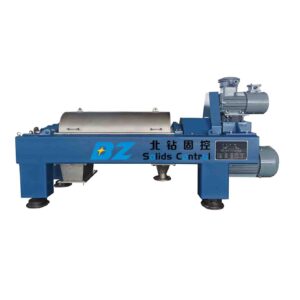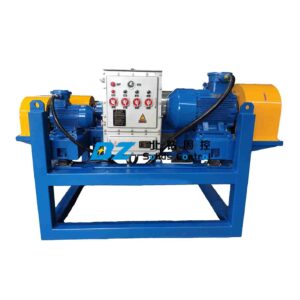BZ Solids Control drilling fluid centrifuge’s structure and working principle
BZ Solids Control drilling fluid centrifuge is also called decanter centrifuge, or centrifuge for short. Its structure is composed of a conical roller, a screw conveyor in the roller, and a transmission connecting the roller and the screw conveyor. The drum can be rotated at a high speed in the range of 1500-3500r/min. The solid-liquid separation is carried out in the drum, and the big end of the drum has an overflow opening. The screw conveyor in the drum is used to transport the liquid phase and the solid phase to the two ends of the drum respectively. The transmission connects the roller and the screw conveyor to make the two rotate in the same direction with a certain speed difference. The rotation speed ratio of the roller and the conveyor is generally 80:79, that is, the roller rotates 80 revolutions and the conveyor rotates 79 revolutions. When the drum speed is 1800r/min, the conveyor has a speed difference of 22.5r/min relative to the drum. This relative speed is exactly the conveying speed of the conveyor.

When the BZ Solids Control drilling fluid centrifuge is working, the drilling fluid to be processed enters the fluid chamber through the fluid inlet pipe, and then enters the separation chamber (that is, the space between the drum and the conveyor) through the fluid inlet. The drilling fluid entering the separation chamber is accelerated by the rotation of the drum to form a cone-shaped liquid ring, commonly known as a liquid pool. The depth of the liquid pool is determined by the height of the overflow ports (usually 8-12) on the end of the drum. Under the action of centrifugal force, the solid particles in the drilling fluid are thrown to the wall of the rotating drum and settle down. According to Stoke’s law, large particles settle first, small particles settle last, and very fine particles that cannot settle are discharged from the overflow with the liquid phase. The settled solid particles are continuously pushed by the conveyor to move to the small end of the drum, and are discharged from the bottom flow port of the small end. Due to the high-speed rotation of the drum, the drilling fluid ring in the separation chamber obtains a large centrifugal force, so that very fine solid particles can be separated, and most of the free water adsorbed on the surface of the solid particles can be thrown off.
 The solids drainage capacity of the BZ Solids Control drilling fluid centrifuge is limited by the conveying speed of the conveyor and the size of the underflow opening. The liquid overflow capacity is limited by the size of the overflow orifice. The drilling fluid input capacity of the centrifuge is separated by the drilling fluid. The volume limit of the solid phase. If the solid phase content is low, the input capacity is limited by the liquid overflow capacity. If the solid phase content is high, the input capacity is limited by the solid phase excretion capacity.
The solids drainage capacity of the BZ Solids Control drilling fluid centrifuge is limited by the conveying speed of the conveyor and the size of the underflow opening. The liquid overflow capacity is limited by the size of the overflow orifice. The drilling fluid input capacity of the centrifuge is separated by the drilling fluid. The volume limit of the solid phase. If the solid phase content is low, the input capacity is limited by the liquid overflow capacity. If the solid phase content is high, the input capacity is limited by the solid phase excretion capacity.
BZ Soldis Control develops and produces medium-speed drilling fluid centrifuges, high-speed drilling fluid centrifuges, and high-speed variable-frequency drilling fluid centrifuges. Welcome to inquiry.
